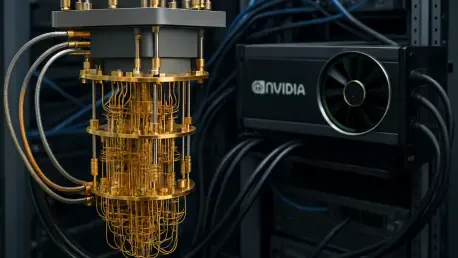In a world where computational challenges are growing exponentially, the race to harness quantum computing has become a defining frontier for technological innovation. QuEra Computing, a trailblazer in neutral-atom quantum technology, has emerged as a key player by securing a substantial $230 million Series B funding round, with a notable investment from NVentures, NVIDIA’s venture capital arm. This financial boost, coupled with strategic alliances, underscores the company’s pivotal role in advancing hybrid quantum-classical systems. By blending quantum capabilities with classical computing power, QuEra is addressing some of the most complex problems that traditional systems struggle to solve. This development signals a transformative shift in the industry, where partnerships with tech giants are paving the way for scalable solutions. The focus on integrating cutting-edge hardware and software positions QuEra at the forefront of a new era, promising to redefine computational possibilities through innovative approaches and collaborative efforts.
Strategic Alliances Driving Innovation
The foundation of QuEra’s progress lies in its high-profile collaborations with industry leaders such as NVIDIA, Amazon Web Services, and Google. These partnerships provide access to advanced computing ecosystems, enabling the development of robust hybrid systems that combine quantum and classical strengths. A standout example is the deepened relationship with NVIDIA, supported by the recent NVentures investment. This alliance emphasizes integrating QuEra’s neutral-atom architecture with NVIDIA’s accelerated computing stack, creating powerful platforms for research and application. Projects like Japan’s ABCI-Q system exemplify this synergy, where a QuEra Gemini-class quantum computer operates alongside thousands of NVIDIA #00 GPUs. Connected through NVIDIA’s CUDA-Q software, this setup serves as a national testbed for fault-tolerant quantum algorithms enhanced by AI-driven workflows, demonstrating how strategic partnerships can push the boundaries of what’s computationally possible.
Beyond international endeavors, QuEra’s collaboration with NVIDIA extends to significant initiatives within the United States, notably at the NVIDIA Accelerated Quantum Center in Boston. Here, QuEra’s cutting-edge hardware is paired with NVIDIA’s GB200 NVL72 GPU clusters to conduct large-scale simulations and advance research into quantum error correction. A remarkable achievement from this partnership is the creation of AI-powered quantum decoders, developed using transformer models trained on NVIDIA’s infrastructure. These decoders outperform traditional methods in scalability and efficiency, marking a critical step toward practical, fault-tolerant quantum systems. This effort highlights the potential of hybrid architectures to solve real-world challenges by leveraging the complementary strengths of quantum and classical technologies. The focus on error correction through AI integration showcases a forward-thinking approach that could redefine standards in the quantum computing landscape.
Market Trends and Technological Impact
The investment from NVentures reflects a broader industry trend favoring hybrid quantum-classical systems as a viable path to practical quantum computing. QuEra’s technology is increasingly seen as a complementary force to GPU-coupled quantum supercomputers, with deployments in high-performance computing centers aimed at reducing adoption barriers for enterprises and institutions. Supported by industry giants, the company is well-positioned to transition from early-stage research to broader market applications. The mission to build scalable, fault-tolerant quantum computers capable of addressing problems beyond classical systems’ reach is rooted in foundational research from prestigious institutions like Harvard and MIT. Additionally, QuEra operates one of the largest publicly accessible quantum computers, available via cloud platforms and for on-premises use, further democratizing access to this transformative technology and fostering wider experimentation across diverse sectors.
A growing consensus within the industry points to the near-term value of hybrid systems, as articulated by QuEra’s CEO, Andy Ory, who emphasized that collaboration with NVIDIA accelerates the journey to useful quantum machines. This shared vision suggests that hybrid architectures could deliver tangible benefits to customers much sooner than previously anticipated. The strategic integration of QuEra’s technology into global computing infrastructures aims to lower entry barriers and expand access to quantum capabilities. This market momentum indicates a shift toward practical applications, where hybrid solutions are not just theoretical but are becoming integral to solving complex computational challenges. The focus on accessibility and integration reflects an understanding that widespread adoption hinges on making quantum technology both powerful and approachable, paving the way for broader societal and industrial impact in the coming years.
Reflecting on Milestones Achieved
Looking back, QuEra’s Series B expansion stood as a defining moment that went beyond mere financial growth, marking a significant stride in the evolution of quantum computing. The partnerships forged with NVIDIA, Google, and Amazon Web Services created a robust framework for innovation, driving tangible progress in hybrid systems. Breakthroughs like AI-driven quantum decoders and large-scale integrations in high-performance centers showcased the potential of combining quantum and classical paradigms. These achievements underscored the industry’s shift toward practical, fault-tolerant solutions that promised to address previously insurmountable challenges. As a next step, stakeholders should focus on scaling these innovations, ensuring that hybrid technologies become more accessible to diverse industries. Continued investment in research and infrastructure will be crucial to sustain this momentum, while exploring new applications could unlock further potential, setting the stage for a future where computational limits are continually redefined.









